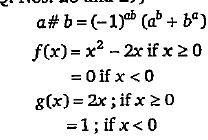If f be a greatest integer function and g be an absolute value function, find the value of (f∘g)(−32)+(g∘f)(43).
Video Solution
Text Solution
The correct Answer is:2
(fog)(−32)=f{g(−32)}=f(∣∣∣−32∣∣∣)=f(392))=[32]=1
(gof)(43)=g{f(43)}=g[43]=g(1)=|1|=1
|
Topper's Solved these Questions
- FUNCTIONSBOOK - RS AGGARWALCHAPTER - FUNCTIONSEXERCISE - Exercise 2C
20 Videos
- FUNCTIONSBOOK - RS AGGARWALCHAPTER - FUNCTIONSEXERCISE - Exercise 2D
11 Videos
- FUNCTIONSBOOK - RS AGGARWALCHAPTER - FUNCTIONSEXERCISE - Exercise 2A
17 Videos
- DIFFERENTIATIONBOOK - RS AGGARWALCHAPTER - DIFFERENTIATIONEXERCISE - Exercise 10I
51 Videos
- FUNDAMENTAL CONCEPTS OF 3-DIMENSIONAL GEOMETRYBOOK - RS AGGARWALCHAPTER - FUNDAMENTAL CONCEPTS OF 3-DIMENSIONAL GEOMETRYEXERCISE - Exercise
18 Videos
Similar Questions
Knowledge Check
If f be greatest integer function defined asf(x)=[x] and g be the mdoulus function defined as g(x)=|x|, then the value of g of (−54) is _____
A-1B0C1D2If f be the greatest integer function and g be the moduls function, then (gof)(−52)−(fog)(−53)=
A1B−1C2D4Let f(x) be the greatest integer function and g(x) be the modulus function.
What is (gof)(−53)−(fog)(−53) equal to?A−1B0C1D2

Find the value of f(g(2#3)+g(f(1#2) :
View SolutionIf f be greatest integer function defined asf(x)=[x] and g be the mdoulus function defined as g(x)=|x|, then the value of g of (−54) is _____
View SolutionIf f(x)=x2−4 and g(x)=[x] ([.] denotes greatest integer function), then the number of negative values in the range of g(f(x)) are.
View SolutionLet f be the exponential function and g be the logarithumic function. Then, find
(i) (f+g)(1) (ii) (fg)(1) (iii) (4f)(1) (iv) (3g)(1)
View SolutionLet f(x) be the greatest integer function and g(x) be the modulus function.
What is (f∘f)(−95)−(g∘g)(−2) equal to?
View Solution

